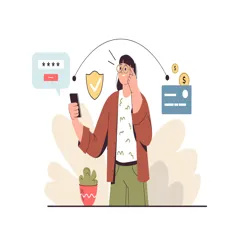EFT payments have revolutionized the way people pay for things. While we regularly use EFT payments for making deposits, receiving payments, or for direct deposits, we don’t always know exactly what’s taking place. As a business owner, a strong understanding of this process is important. By learning more about EFT and how it works, we can see how electronic funds transfers increase a company’s bottom line and assist in serving customers, vendors, and suppliers alike. Read on to understand the meaning of EFT payments and how electronic payments can transform your business.
What Does EFT Stand For?
The term “EFT” stands for “electronic funds transfer.” By definition, it is a blanket term for electronic transfers for payment processing. Moreover, it describes the nature of a transaction or payment being transferred from one account to another via electronic means.
EFT Payment Meaning
So, what is EFT payment processing? And what does this form of electronic processing mean for a business?
An EFT payment describes a generic digital activity that defines several types of electronic payments. These payments include automated clearing house (ACH) transfers from banks and wire transfers. EFT presents a helpful solution for sending dependable and quick payments on time.

In 2018, almost 100% of government salaries were paid through EFT processing. The IRS also issued around 84% of tax refund payments through EFT processing.
For millions of people, the use of EFT networking allows 24-hour access to cash and account information. In addition, the use of EFT processing prepares businesses for tomorrow’s economy with dependable and safer methods for issuing payments. To understand the EFT meaning and definition more fully, you need to review its history.
EFT history
The use of EFT first appeared in the 1960s with the introduction of the automated teller machine (ATM). The machine enabled banks and customers to initiate transfers, withdrawals, and deposits using a plastic, magnetic-striped card and personal identification number or PIN.
At the time, customers could only use ATMs at branch banking locations. Shortly after, banks created shared ATMs, where a customer could use another bank’s ATM for withdrawals, after disputes arose over the machine’s limited use.
After that, EFT networking spread rapidly. This type of access increased dramatically after the Supreme Court supported a prior Court of Appeals decision, finding that ATMs could not represent branches of banks.
When you fast-forward ATM use to the 21st-century, you can see how the use of EFT networking is now an accepted and highly popular way to do business. Merchants, governmental agencies, vendors, and individuals all rely on the use of EFT processing through a shared banking network in the U.S. Regardless of whether the transaction involves contactless payments, debit cards, direct deposits, or e-transfers, the payments process quickly and effectively.
Types of Electronic Funds Transfers
You can send money through EFT payment in one of several ways. So what is an EFT payment? The following listing will provide more clarification.
1. Electronic check
An electronic check, or eCheck, is an EFT payment that is the electronic equivalent of a paper check. Banks use a bank account number, ACH trace number, and bank routing number to deposit checks. Tokens and encryption help keep the data safe.
2. ATMs
ATMs are an electronic funds transfer that lets account holders access funds remotely without teller services. These machines allow EFT payment processing at ATM stations or branch banks. Transactions include cash deposits and withdrawals and the transfer of funds.
3. Debit card charges
A debit card is a form of EFT payment processing that uses a debit card issued by a credit union or bank to move money between financial institutions. Customers can pay with a debit card over the phone, online, or through a point-of-sale (POS) system.
4. Personalized computer banking
Most banking transactions fall under this form of EFT payment processing. This type of banking transaction allows the user to make EFT payments through a mobile device, tablet, or PC connected to the Internet.
5. Wire transfer
A wire transfer offers an efficient and quick means to send money for large and high-value payments. Wire transfers are frequently used to provide down payments on physical assets, such as real estate.
6. Direct deposit
Also called an ACH transfer, this electronic funds transfer payment allows for employers to directly pay an employee (the receiver) electronically in his or her bank account. A direct deposit service provider authorizes payments into employee accounts.
Companies also pay vendors and suppliers using this payment method. Doing so allows them to keep their inventories up to date and customer orders filled.
7. Banking by phone
EFT payment processing may also take place over the phone with the caller providing their debit or credit card details.
Each of the above-described EFT payment types share a common thread, as they all use the ACH network. However, different payments carry different fees. However, fees differ based on the transaction method and location.
What’s the Difference Between ACH and EFT?
Whenever payment processors describe the EFT payment meaning, the definition of the ACH network also comes up. Definitively, an ACH (automated clearing house) transfer refers to a digital exchange between participating banks and financial services businesses.
There is no clear difference between ACH and EFT, because, in a sense, they represent one and the same activity. Therefore, you might consider an ACH transaction a subcategory of EFT processing where payments are sent through the ACH network for authorization.
However, EFT is more broad, as it also involves point-of-sale (POS) transactions and the use of debit and credit cards. Today, all major financial institutions in the U.S. support ACH transactions to facilitate EFT processing and billing.
In simplest terms, an ACH transfer is basically a type of EFT used by various industries for security purposes and low fees. In fact, it was originally designed to replace the use of physical checks.
Benefits and Risks of EFTs
Now, you may be wondering about the advantages and drawbacks of EFT. The following summation gives you reasons why EFT payment processing can be helpful, or in some instances, risky.
The benefits of EFT payment processing
Using EFT payment processing offers businesses an economical way to save money and time. You can also derive the following benefits:
- Not paying postage for billing
- Saving on check cashing costs
- Safe, fully encrypted SSL 128-bit information
- Transitions that are simple to track
Risks of EFT processing
While transactions are encrypted for safe processing of EFT payments, users still need to ensure their electronic payment processing remains that way. To reduce risks, businesses need to follow certain measures, specifically:
- Requiring periodic changes of the default password for the administrator account and maintain passwords to default IDs in a safe location
- Requiring dual authorization for creating or deleting users and for EFT file releases to a bank
- Follow timely maintenance schedules of user accounts
- Restrict failed login attempts to each application
- Limit EFT dollar amounts for transmissions

At first, it may seem a bit scary for consumers to share their bank account details, allowing a business to electronically debit their account. However, the Electronic Funds Transfer Act (EFTA) gives EFT users a legal means to address risk. Under this act, consumers enjoy the following protections:
- Unauthorized transactions: Consumers can report an unrecognized transaction to their bank or financial institution within 60 days to investigate the activity. However, users must report the activity within this period to avoid total liability.
- Stolen or lost debit cards: If a debit card is reported lost or stolen within two days, the EFTA limits the user’s liability to $50 for unauthorized transactions. Again, you need to report any unrecognized use within 60 days to avoid total liability for unauthorized transactions.
- Violation of consumer rights: A consumer can recoup any damages from a bank violating their EFTA rights.
- Withdrawal limits: Banks can place withdrawal limits on debit cards to prevent excessive and unauthorized withdrawals.
Obviously, time is of the essence when limiting liability.
EFT payment processing gives businesses an edge when it comes to business and customer relations and cash flow. By understanding the EFT payment meaning and how the process works, you can benefit from using this type payment processing and increase your influence online and offline.
How Long Does It Take to Process an EFT Payment?
When compared to printing checks and mailing them, EFT processing is far more lucrative, if not more secure and practical. While it takes seconds to initiate an EFT payment transaction, it takes banks 1 to 3 days to process the payments, or for the money to end up in a business’s bank account. Some EFT payments, such as wire transfers, are received the same day.
In today’s accounts payable departments, businesses do not want to spend a long time processing paper checks, nor do they want to experience other delays. By using EFT payment processing, companies can pay vendors and suppliers by an EFT payment, such as direct deposit or ACH.
Factors that affect processing times
The payment processing time depends on the:
- Submission date
- Transfer provider
- Type of payment
EFT payments process during the business week–not on weekends. Therefore, they are regularly processed Monday through Friday. Cutoff times also affect payment processing. For instance, you may transfer money before 9:00 p.m. for same-day processing. However, if a transaction goes through after that time, it will not process until the next business day.






